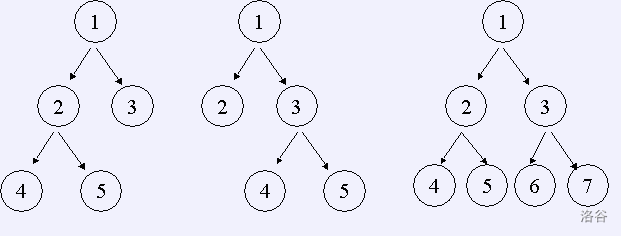Description
如果一棵树的所有非叶节点都恰好有 (n) 个儿子,那么我们称它为严格 (n) 元树。如果该树中最底层的节点深度为 (d)(根的深度为 (0)),那么我们称它为一棵深度为 (d) 的严格 (n) 元树。例如,深度为2的严格2元树有三个,如下图:

给出 (n,d),编程数出深度为 (d) 的 (n) 元树数目。
Input
仅包含两个整数 (n,d(0<n leqslant 32,0 leqslant d leqslant 16))。输入数据保证你不需要考虑某一层多于 10241024 个节点的树(即 (nd leqslant 1024))。提示:答案保证不超过 200 位十进制数。
Output
仅包含一个数,即深度为 (d) 的 (n) 元树的数目。
Sample Input 1
2 2
Sample Output 1
3
Sample Input 2
2 3
Sample Output 2
21
Sample Input 3
3 5
Sample Output 3
58871587162270592645034001
我们首先考虑(n=2)的情况,记(F_x)表示深度为(x)的严格(n)元树个数,(S_x=sumlimits_{i=1}^xF_i),我们考虑(F_x)如何转移到(F_{x+1})
考虑到深度增加,故我们新引入一个根节点,不难发现,(F_{x+1})的所有情况,其左右子树的深度均小于(x+1),故可得所有的情况数为(S_x^2)。显然,在这些情况中存在不合法的情况,因为要保证深度为(x+1),故子树至少有一个深度需要达到(x),用容斥原理可得(F_{x+1}=S_x^2-S_{x-1}^2)
那(n eq 2)呢?很显然这(n)个子节点是互相独立的,故可得(F_{x+1}=S_x^n-S_{x-1}^n)
/*program from Wolfycz*/
#include<map>
#include<cmath>
#include<cstdio>
#include<vector>
#include<cstring>
#include<iostream>
#include<algorithm>
#define Fi first
#define Se second
#define ll_inf 1e18
#define MK make_pair
#define sqr(x) ((x)*(x))
#define pii pair<int,int>
#define int_inf 0x7f7f7f7f
using namespace std;
typedef long long ll;
typedef unsigned int ui;
typedef unsigned long long ull;
inline char gc(){
static char buf[1000000],*p1=buf,*p2=buf;
return p1==p2&&(p2=(p1=buf)+fread(buf,1,1000000,stdin),p1==p2)?EOF:*p1++;
}
template<typename T>inline T frd(T x){
int f=1; char ch=gc();
for (;ch<'0'||ch>'9';ch=gc()) if (ch=='-') f=-1;
for (;ch>='0'&&ch<='9';ch=gc()) x=(x<<1)+(x<<3)+ch-'0';
return x*f;
}
template<typename T>inline T read(T x){
int f=1; char ch=getchar();
for (;ch<'0'||ch>'9';ch=getchar()) if (ch=='-') f=-1;
for (;ch>='0'&&ch<='9';ch=getchar()) x=(x<<1)+(x<<3)+ch-'0';
return x*f;
}
inline void print(int x){
if (x<0) putchar('-'),x=-x;
if (x>9) print(x/10);
putchar(x%10+'0');
}
const int maxn=1e2;
const int base=1e4;
const int digit=4;
struct Bignum{
int V[maxn],len;
Bignum(){memset(V,0,sizeof(V)),len=1;}
void init(){V[0]=1;}
void read(char *s){
int l=strlen(s),t=1;
reverse(s,s+l); len=(l-1)/digit+1;
for (int i=0;i<l;i++) V[i/digit]+=(s[i]-'0')*t,t*=10,t%=base;
}
void write(){
printf("%d",V[len-1]);
for (int i=len-2;~i;i--) printf("%0*d",digit,V[i]);
putchar('
');
}
}F[maxn],S[maxn];
Bignum operator +(Bignum x,Bignum y){
Bignum z; z.len=max(x.len,y.len);
for (int i=0;i<z.len;i++) z.V[i]+=(x.V[i]+y.V[i]),z.V[i+1]+=z.V[i]/base,z.V[i]%=base;
while (z.V[z.len]) z.V[z.len+1]+=z.V[z.len]/base,z.V[z.len]%=base,z.len++;
return z;
}
Bignum operator -(Bignum x,Bignum y){
Bignum z; z.len=max(x.len,y.len);
for (int i=0;i<z.len;i++){
z.V[i]+=(x.V[i]-y.V[i]);
if (z.V[i]<0) z.V[i]+=base,z.V[i+1]--;
}
while (!z.V[z.len]&&z.len>1) z.len--;
while (z.V[z.len]) z.V[z.len+1]+=z.V[z.len]/base,z.V[z.len]%=base,z.len++;
return z;
}
Bignum operator *(Bignum x,Bignum y){
Bignum z; z.len=x.len+y.len;
for (int i=0;i<x.len;i++)
for (int j=0;j<y.len;j++)
z.V[i+j]+=x.V[i]*y.V[j],z.V[i+j+1]+=z.V[i+j]/base,z.V[i+j]%=base;
while (!z.V[z.len]&&z.len>1) z.len--;
while (z.V[z.len]) z.V[z.len+1]+=z.V[z.len]/base,z.V[z.len]%=base,z.len++;
return z;
}
Bignum mlt(Bignum a,int b){
Bignum res; res.init();
for (;b;b>>=1,a=a*a) if (b&1) res=res*a;
return res;
}
int main(){
// freopen(".in","r",stdin);
// freopen(".out","w",stdout);
int n=read(0),d=read(0);
F[0].V[0]=1,F[1].V[0]=1;
S[0]=F[0],S[1]=F[0]+F[1];
for (int i=2;i<=d;i++){
F[i]=mlt(S[i-1],n)-mlt(S[i-2],n);
S[i]=S[i-1]+F[i];
}
F[d].write();
return 0;
}